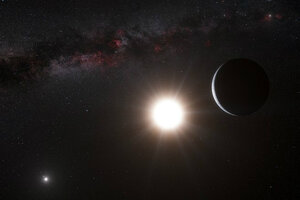Is an Earthlike planet orbiting Alpha Centauri? 'Project Blue' will take a look.
A new initiative seeks to capture visible-light images of the Alpha Centauri star system in hopes of identifying an Earthlike planet in its orbit.

An artist's depiction of our closest star neighbor, Alpha Centauri. Some astronomers believe an Earth-like exoplanet might orbit within the star system's habitable zone.
ESO/L. Calçada/Nick Risinger
Could another "Pale Blue Dot" be just outside our cosmic neighborhood?
"Project Blue," announced on Tuesday, aims to find out. Its researchers will attempt to capture visible-light images of the Alpha Centauri star system in hopes of identifying an Earthlike planet in its orbit. The collaboration includes space research nonprofits Mission Centaur and the BoldlyGo Institute, as well as the Search for Extraterrestrial Intelligence (SETI) Institute and the University of Massachusetts at Lowell.
“We know we need to go to space ... to directly image small planets around nearby stars that are Earth-class terrestrial planets, and the scientists all have this idea of finding Earth 2.0,” Jon Morse, chief executive of the BoldlyGo Institute, told Space.com. “Let's take that Pale Blue Dot image around another star.”
The Alpha Centauri star system is our closest neighbor in the Milky Way galaxy. That’s why the titular star, along with its red dwarf companion Proxima Centauri, are such a good place to start in the search for habitable exoplanets. In August, researchers discovered a prime new candidate within the latter star's habitable zone: Proxima b. But most existing data from the system are based on proxies – the wobbling behavior of Proxima Centauri, for example, tipped off astronomers that some planet was tugging on the star.
Project Blue researchers plan to develop a “relatively small and inexpensive” space telescope in an effort to image such planets directly. The device would theoretically be able to capture blue and green wavelengths from the Alpha Centauri region, which could provide clear evidence of Earthlike planets.
“Once something like this is found, all kinds of other people would look at it in different colors – infrared, which could then give you some idea of temperature and so forth,” said Project Blue team member Supriya Chakrabarti, an astrophysicist at UMass-Lowell.
Researchers hope to launch the refrigerator-sized telescope into orbit by 2019.
But Project Blue isn’t the only initiative with Alpha Centauri ambitions.
Physicist Stephen Hawking, Russian billionaire Yuri Milner, former NASA research director Pete Worden and Facebook CEO Mark Zuckerberg have all collaborated on Breakthrough Starshot, a plan to send thousands of laser-guided ships to the nearby star system.
But the vessels, which would be just about the size of a postage stamp, face incredible technical and logistical challenges. Near-light-speed travel requires a lot of energy, and collisions with interstellar gas particles at such speeds could destroy the craft. And deep space communications are trouble enough, never mind the difficulty of obtaining readings from a tiny robot speeding through a distant star system.
So for now, a blurry snapshot from a distance might be a big enough leap for Project Blue.
"We're taking the first step," said Professor Chakrabarti. "After that, there will be a lot more detailed investigations, which will tell us a lot more."

